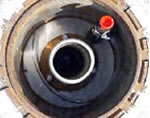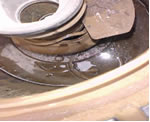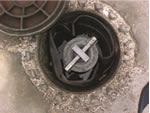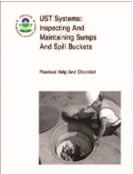By Nancy W. Teolis, J.D.,
BLR Legal Editor-Environmental
nteolis@blr.com
Federal rules require USTs to be protected from spills, overfills, and corrosion.
What is a Spill Bucket?

Spill Bucket
USTs must have spill buckets at each fill pipe where fuel is delivered into the UST to contain spills that may occur as a result of fuel deliveries. Spill buckets need to be large enough to contain any fuel that may spill when the delivery hose is uncoupled from the fill pipe. Spill buckets typically range in size from 5 to 25 gallons.

Diagram of UST system
What can you do to prevent spills from spill buckets?
Spill prevention is required for every UST that is filled with more than 25 gallons of product at one time. Spill prevention devices attached to your UST (such as a spill bucket) can help prevent releases into the environment.
Repeated small releases can cause big environmental problems. Spill buckets can be a common source of spills. Improper maintenance of your spill bucket may contribute to significant soil and groundwater contamination.
![]() Remove debris/liquid in spill buckets
Remove debris/liquid in spill buckets
Spill buckets are designed to temporarily contain small product spills released during delivery and are not for long-term storage of product. Accumulated debris or liquid reduces containment capacity and ability to prevent spills.
Keep your spill buckets clean and dry. Empty spill buckets immediately and properly dispose of the contents. A spill bucket may have a drain valve to drain fuel back into the tank.

What’s wrong with this picture?
Keep in mind, however, that when you pump out or drain your spill bucket into your UST, any water or debris may also enter the UST. If a basin is not equipped with a drain valve or pump, then any accumulated fuel or water must be removed manually and disposed of properly.
![]() Replace damaged gaskets and seals
Replace damaged gaskets and seals
Damaged seals and gaskets can result in non-tight spill buckets. This can allow a release into the environment.

Damaged seal
Periodically inspect all seals—including around the fill riser—for any cracks, damage, or holes. Replace or repair, as needed.
![]() Repair or replace damaged spill buckets
Repair or replace damaged spill buckets
Damaged, cracked, or corroded spill buckets are not liquid-tight and will not contained the spilled product.

Damaged spill bucket wall
Most spill containment is not designed to last as long as a UST. Periodically inspect for damage, corrosion, and deformation. Perform an integrity test and, if necessary, repair or replace to make sure it works properly.
 Remember
Remember
R A damaged, missing, or poorly fitting spill bucket lid may allow water and debris to collect in the spill bucket and enter into the tank.
R Inspect spill buckets before and immediately after product delivery. Remove spilled product immediately.
R Keep spill buckets clean and free of liquids and debris.
–Inspect spill buckets after it rains, or after snow melts
–Dispose of liquid properly
R Repair or replace damaged or cracked spill buckets and lids immediately.
R Inspect and replace damaged spill bucket drain valves immediately.
If you are not sure about the tightness of your spill buckets, have a qualified service technician test them for leaks.
Resource: For additional inspection guidelines and best management practices for UST system spill buckets, including safety practices, see EPA’s manual, UST Systems: Inspecting and Maintaining Sumps and Spill Buckets—Practical Help and Checklist
This is part of a series of UST Best Management Practices (BMPs) designed to help owners and operators comply with UST regulations. Future BMPs will include UST overfill protection, and tank and piping release detection.

Nancy W. Teolis, J.D., has been a Legal Editor for BLR’s environmental law publications since 1993, focusing primarily on underground storage tanks, pesticides, and hazardous waste-related requirements. Before joining BLR, she worked for the law firm Rudman & Winchell in Bangor, Maine, with an emphasis on asbestos exposure litigation. She received her law degree from Western New England University School of Law in Springfield, Massachusetts, and is a member of the Connecticut bar.

